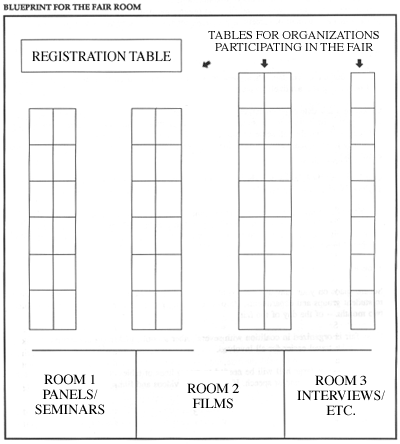CAREERS FAIR STRUCTURE
What
The fair should be a one-day event, to which representatives from local, regional and national social change groups are invited to speak, participate in panel discussions, give workshops, show films and talk with students about their work and job opportunities. If possible, one major speaker -- prominent and active in the social change movement -- should be invited to kick off the day's events with a speech inspiring students to consider socially responsible careers. At least four to five hours of organizations staffing information tables and coordinated activities -- videos and films on organizing, panel discussions, workshops on the possibilities and pursuit of careers in the public interest field, pre-scheduled interviews -should follow.
When
Plan the fair on a weekday, when guest speakers and group representatives are working and will be willing and available to participate.
Choosing a fair date depends largely on the availability of the facilities you plan to use. Investigate your options in the summer or at the beginning of the fall semester if planning a fall fair, or during the fall semester for a spring fair. Early planning will allow more flexibility in organizing around other factors, such as semester breaks, exam periods, other big events, etc.
Consider the schedules of neighboring campuses you will work with in organizing the fair. Try not to set a date that falls in their school breaks, mid-term or final exam weeks.
A spring fair is preferable, since this is the time when most students begin their job and internship searches and so will be better prepared to use the fair's resources. Likewise, organizations will want to visit in the spring when students are close to being available to accept jobs and internships.
Where
Secure space on your campus or a neighboring campus for the fair. Such space is usually free to student groups and departments. Be sure to make your request well in advance -- at least two months -- of the day of the fair.
If the fair is organized in coalition with several other schools, pick a central campus as the site to make travel easier for all involved.
A gymnasium or large hall will be needed to set up lines of tables, with a smaller space for the news conference and/or speech. If showings of videos and films, panel discussions or additional lectures are planned, try to obtain the use of rooms adjacent to or in the same building as the fair.
Videos on citizen organizing, specific campaigns and social and environmental issues (see Appendix A) can also be shown in a coma of the room where the fair is held. Set up chairs around the screen or television so that students may watch while looking through literature collected from the tables.
